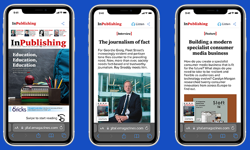Having just published the first issue of a niche magazine for foreign English learners in Cambridge, I was asked to consider what it was like to transform an MA dissertation business plan into a real, live business.
Prior to studying a Master’s in Publishing, I worked in the English language teaching (ELT) industry in various countries. When I came back to Cambridge with this experience, I realised there was potential for creating a central place where students from all the local language schools could publish their (often reams of) written work and communicate with one other to bolster their learning experience. I then realised that if it became a publication which also generated revenue through advertising, it could be a viable business too.
As a student of the MA in Publishing at Anglia Ruskin University in Cambridge, I took the dissertation option to create a business plan. Then, having tried to consider everything about how to operate a monthly magazine called the International Student Times, I waded into starting the business in November 2010. I set the first publication date as 1st February 2011.
The planning meant that on going to schools to ask for contributions, I could speak confidently about the magazine and what it could offer them and their students, but I always remained nervous of a ‘That’s nice dear!’ response. I knew it was unrealistic to expect people to spend extra time at work on someone else’s ‘nice’ idea. I didn’t have a product or even a logo yet, but thankfully people were very enthused and I found some Directors of Studies who were willing to take a chance.
In the beginning, therefore, I concentrated on forming partnerships with two or three schools so I could properly establish what they needed from me, and so I would have room to make mistakes. I believed the IST would work, but if the whole thing never got off the ground for a while, I didn’t want to burn bridges. My link with the university really helped here too when they valued the IST as a new student venture.
And I hate being late. So when I told the schools it would be February, there was little doubt it would be February. Still, no amount of enthusiasm from myself or the schools would cover design, print and production costs, and my pitches to potential advertisers at this point understandably often elicited a friendly form of ‘No’.
So come rain, shine or snow, I needed that first issue created, printed and out there. But by then, it was heading towards the end of term and Christmas. With people’s minds on holidays rather than new projects, much of the expected content didn’t come through ... I spent Christmas and New Year writing a magazine.
Then, with a patient designer and printer who were willing to work with a rookie, and who understood what I was trying to do, Issue 1 came out as a pretty attractive magazine ... and schools liked it and wanted it.
Having the first issue out there has already opened up a lot of other possibilities and connections I had never considered before, so the excitement (and fear!) continues. My main focus right now is on building relationships with schools and finding ways for them to generate content regularly. The magazine needs to be sustainable and I need everyone’s enthusiasm to continue. It won’t work if it’s just me who thinks it’s a useful idea; I rely on a lot of people thinking the same thing.
If I was asked for tips I would give to others considering a magazine start-up, I would say firstly that it’s well worth doing the planning first and asking yourself the really difficult ‘What if ...?’ questions. That way, the ‘unexpected’ challenges that inevitably occur at the beginning aren’t really unexpected at all - they are just a bit bigger or smaller than predicted, and something can be done about them. Secondly, of course, it’s all about time (that there isn’t enough of it!) and time management. There are a lot of deadlines. When Issue 1 was finally signed, sealed and delivered, I was under pressure on Issue 2. It’s a continuous process.
Lastly, accept offers of help from friends, family and associates – it’s not only practical, but they can also challenge your ideas and keep you on track.
But then I’m only one and a half issues in, so there’s plenty more to learn yet!










